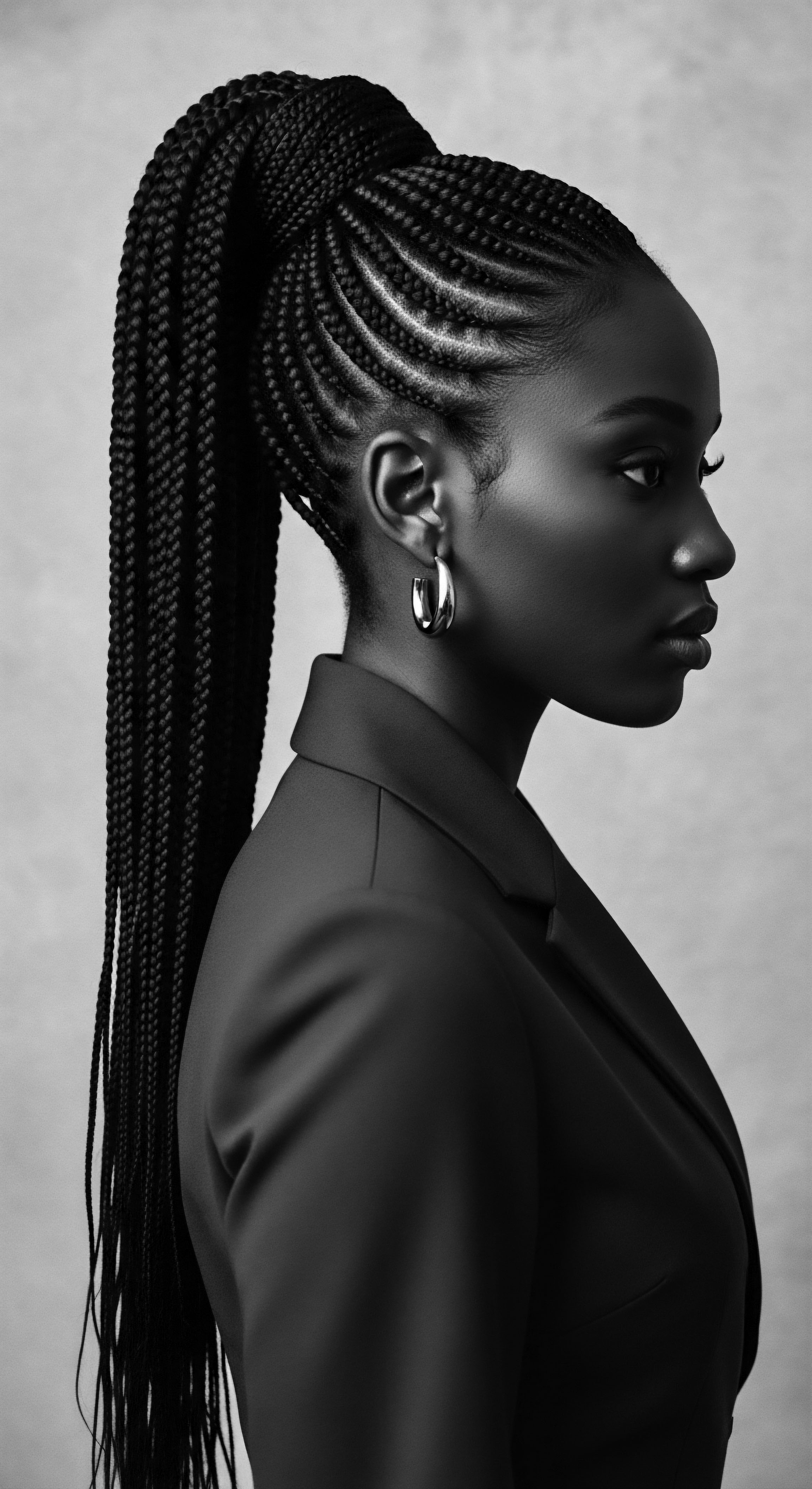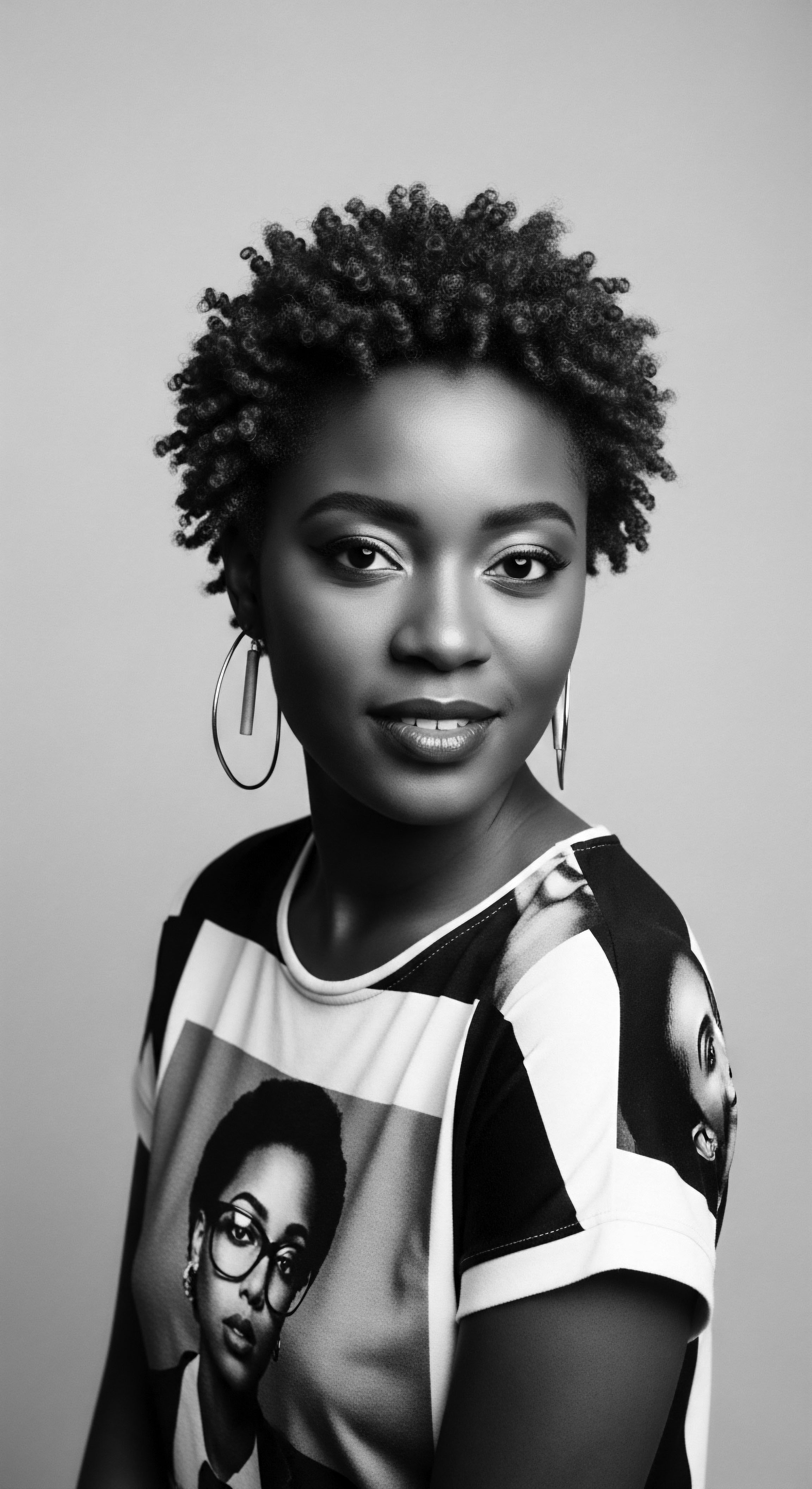
Fundamentals
The Cultural Food Systems, within the expansive living library of Roothea, signifies far more than a mere collection of ingredients or culinary practices. It represents the intricate web of ancestral knowledge, communal rituals, and biological wisdom that has historically sustained and celebrated textured hair across diverse Black and mixed-race communities. This designation extends beyond what is consumed internally; it encompasses the topical applications, the botanical preparations, and the communal acts of care that nourish the scalp and strands. The fundamental understanding of this concept begins with recognizing hair, particularly textured hair, not as a separate entity but as an extension of the body’s holistic well-being, deeply connected to the earth’s offerings and the hands that tend them.
Its meaning lies in the recognition that hair health is not solely a matter of genetics or modern chemistry, but a continuous dialogue with the environment and inherited traditions. The term acknowledges that for generations, communities relied upon their immediate surroundings – the plants, minerals, and natural elements – to create systems of care that maintained hair integrity and beauty. This involves understanding the indigenous plants used for their properties, the methods of preparation, and the communal practices that transformed hair care into a shared experience.
The Cultural Food Systems defines the profound, historical connection between ancestral sustenance, botanical wisdom, and the vibrant health of textured hair across generations.
The core delineation of Cultural Food Systems for textured hair begins with the recognition that these practices were not random. They were often rooted in deep observation of nature and the physiological responses of the hair and scalp. For instance, the use of various plant extracts in traditional African hair care, such as Shea Butter, Coconut Oil, and Aloe Vera, reflects an ancient understanding of their moisturizing, protective, and soothing properties.
These elements, sourced directly from the earth, formed the bedrock of hair wellness long before the advent of modern cosmetic science. The practices were often intertwined with daily life, seasonal rhythms, and rites of passage, embedding hair care within the very fabric of cultural identity.

The Elemental Origins of Hair Nourishment
At its simplest, the Cultural Food Systems describes how early human communities interacted with their natural environments to sustain hair health. This often involved a keen awareness of local flora and fauna, recognizing which plants offered moisturizing qualities, which possessed cleansing abilities, or which could offer protection from the elements. The basic components were often plant-based, reflecting an intimate relationship with the land.
- Shea Butter (Vitellaria Paradoxa) ❉ This rich emollient, derived from the nuts of the African shea tree, has been a cornerstone of West African hair care for centuries, valued for its deeply conditioning and protective qualities.
- Coconut Oil (Cocos Nucifera) ❉ A staple in many tropical regions, coconut oil is recognized for its ability to penetrate the hair shaft, offering conditioning and strength, particularly for textured strands.
- Aloe Vera (Aloe Barbadensis Miller) ❉ The gel from this succulent plant provides soothing hydration and scalp benefits, a traditional remedy in numerous cultures for various skin and hair conditions.
These foundational ingredients, and the methods of their preparation, represent the initial layers of the Cultural Food Systems. They speak to a time when sustenance for the body and care for the hair were inseparable, both sourced from the generosity of the natural world.

Intermediate
Moving beyond the elemental, the intermediate meaning of Cultural Food Systems for textured hair reveals a complex interplay of ecological wisdom, community practice, and the development of sophisticated care rituals. This level of understanding acknowledges that the “food” in Cultural Food Systems extends beyond simple ingestion, encompassing the full spectrum of external nourishment applied to hair and scalp, alongside the dietary practices that influence internal well-being. The interpretation here delves into how specific communities, particularly those with textured hair, adapted and innovated with their local resources to create resilient systems of hair care that were simultaneously practical, symbolic, and deeply communal.
The delineation here centers on the collective and intergenerational transfer of knowledge. It is not merely about using a plant, but understanding how to process it, combine it, and apply it in ways that honor its properties and serve the specific needs of textured hair. This might involve complex fermentation processes, specific extraction techniques, or precise application methods passed down through oral traditions and lived experience.
The significance of these systems becomes clearer when we consider the social and spiritual dimensions of hair care within Black and mixed-race communities. Hair, as a visible marker of identity, status, and spirituality, demanded a robust system of care that the Cultural Food Systems provided.

The Communal Hearth of Hair Traditions
The intermediate understanding of Cultural Food Systems highlights how hair care was often a communal activity, a space for storytelling, wisdom sharing, and social bonding. From mothers braiding their daughters’ hair to community salons serving as hubs of connection, these practices reinforced community ties and preserved cultural heritage.
For example, the Maasai Community in East Africa provides a compelling case study. Hair rituals are integral to various rites of passage, symbolizing new stages of life and spiritual connections. This includes specific hair shaving and re-growing processes, demonstrating a profound link between hair, personal journey, and collective identity. Such practices underscore that Cultural Food Systems are not static; they are living traditions, adapting while retaining their core meanings.
| Traditional Ingredient Chebe Powder |
| Source/Origin Chad (Basara Arab women) |
| Primary Application for Textured Hair Hair strengthening, length retention (topical) |
| Associated Benefit (Traditional & Modern) Reduces breakage, promotes hair growth by strengthening strands. |
| Traditional Ingredient Rhassoul Clay |
| Source/Origin Morocco (Atlas Mountains) |
| Primary Application for Textured Hair Cleansing, detoxifying scalp treatment |
| Associated Benefit (Traditional & Modern) Removes impurities without stripping natural oils, adds volume. |
| Traditional Ingredient Fenugreek (Methi) |
| Source/Origin India, Middle East, North Africa |
| Primary Application for Textured Hair Hair growth stimulation, conditioning (topical & internal) |
| Associated Benefit (Traditional & Modern) Supports scalp health, reduces hair fall, imparts shine. |
| Traditional Ingredient Baobab Oil |
| Source/Origin Africa (Baobab tree seeds) |
| Primary Application for Textured Hair Moisturizing, softening, elasticity enhancement |
| Associated Benefit (Traditional & Modern) Rich in fatty acids, provides deep conditioning and protects against dryness. |
| Traditional Ingredient These ingredients, often prepared through time-honored methods, illustrate the depth of ancestral knowledge embedded within Cultural Food Systems. |
The Cultural Food Systems, therefore, represents a legacy of adaptive ingenuity, where local resources were not merely consumed but transformed into a vital source of care, beauty, and identity for textured hair, affirming a connection to ancestral wisdom that spans continents and generations.

Academic
The academic delineation of Cultural Food Systems, particularly in the context of textured hair heritage, transcends a simplistic interpretation of diet or topical application. It constitutes a complex, biocultural phenomenon, a profound statement on human adaptation, cultural resilience, and the deeply embodied politics of identity. This meaning posits that Cultural Food Systems represent the holistic, historically contingent, and culturally specific frameworks through which communities, especially those of Black and mixed-race descent, have sourced, prepared, and utilized natural resources—both for internal sustenance and external cosmetic application—to maintain, express, and protect their textured hair. This encompasses the reciprocal relationship between environmental ecology, ethno-botanical knowledge, and the socio-political landscapes that have shaped hair practices over millennia.
The explication of Cultural Food Systems requires an interdisciplinary lens, drawing from anthropology, ethnobotany, public health, and material culture studies. It acknowledges that hair, particularly for people of African descent, has never been a mere aesthetic choice; it has served as a powerful medium for communication, social stratification, spiritual connection, and resistance against oppressive beauty norms. The products and practices within these systems are not accidental; they are the cumulative result of generations of empirical observation, spiritual reverence, and practical innovation.

The Deep Roots ❉ Ethnobotany and Ancestral Hair Science
A critical component of the Cultural Food Systems is the deep ethnobotanical knowledge that underpins traditional hair care. This involves understanding the specific plant species utilized, their bioactive compounds, and the methods of extraction and preparation that maximize their efficacy for textured hair. For example, research into traditional African hair treatments reveals a compelling overlap between plants used for hair health and those with antidiabetic properties, suggesting a systemic, holistic understanding of wellness that links external appearance to internal physiological balance (Kandawire, 2024, p.
1-2). This indicates that ancestral practices often recognized a connection between diet, topical applications, and overall bodily health, a sophisticated understanding that modern science is only beginning to fully appreciate.
Consider the widespread use of Nigella Sativa, or Black Cumin Seed Oil, across various cultures for hair health. While modern studies validate its anti-inflammatory and antioxidant properties, traditional practices have long utilized it for promoting hair growth and scalp vitality. This traditional application, rooted in generations of observation, predates contemporary scientific validation, demonstrating an indigenous scientific literacy.
Cultural Food Systems, in its deepest sense, is a living archive of human ingenuity, where the sustenance of body and strand intertwine through generations of inherited wisdom and ecological harmony.
Furthermore, the meaning of Cultural Food Systems is profoundly shaped by historical experiences, particularly the transatlantic slave trade and its enduring legacy. During enslavement, the deliberate shaving of African hair was a brutal act of dehumanization, a systematic attempt to strip individuals of their cultural identity and spiritual connection. Despite this profound disruption, ancestral hair practices persisted, often in secret, becoming powerful acts of defiance and cultural preservation. This resilience speaks to the enduring power of Cultural Food Systems as a mechanism for cultural survival and identity assertion.
The Cultural Food Systems also illuminates the concept of “hair texture as a weaponized social construct”. Post-slavery, a caste system emerged where straighter hair textures were often privileged, forcing many Black individuals to manipulate their natural hair to conform to Eurocentric beauty standards. This historical context underscores how Cultural Food Systems became not just about physical care, but also about psychological well-being and the reclamation of self-worth. The “Natural Hair Movement” of the 1960s and 2000s, for instance, represents a conscious return to and celebration of ancestral hair practices, a collective re-engagement with Cultural Food Systems as a form of cultural pride and resistance.

Interconnected Incidences ❉ The Biocultural Impact on Hair
The intricate connection between internal dietary practices and external hair health within Cultural Food Systems is a rich area of academic inquiry. A study published in the Journal of Nutrition by University of Alaska Fairbanks researchers linked specific chemical signatures in human hair to a diet of traditional Yup’ik foods, such as fish and marine mammals (O’Brien, 2019). This research demonstrates how the very composition of hair can serve as a biomarker, reflecting the nutritional input from traditional food systems. While this specific study focuses on Indigenous Alaskan populations, its findings offer a profound analogue for understanding the deep biological imprints of Cultural Food Systems on textured hair across other communities.
It provides empirical validation for the long-held ancestral understanding that what nourishes the body also nourishes the hair. This suggests that the health and vitality of textured hair are not merely surface-level concerns but are intrinsically linked to the bioavailability of nutrients derived from culturally specific dietary patterns.
The implications for textured hair are significant. When traditional food systems are disrupted—whether through forced migration, colonization, or the pressures of globalization—the nutritional inputs vital for healthy hair can be compromised. This can manifest in changes to hair structure, growth patterns, and overall resilience. Therefore, the study of Cultural Food Systems in relation to textured hair becomes a critical examination of how historical injustices and ongoing socio-economic disparities can impact biological expressions of heritage.
The academic understanding of Cultural Food Systems, then, is a comprehensive framework for examining the dynamic relationship between cultural practices, environmental resources, and the biological expression of textured hair. It offers a powerful lens through which to comprehend the enduring wisdom of ancestral care, the historical struggles for identity, and the ongoing efforts to reclaim and celebrate the richness of Black and mixed-race hair heritage.
- Ethnobotanical Survey in Ghana ❉ Research in the Dormaa Traditional Area of Ghana documented indigenous cosmetic hair variants like Shea Butter, Charcoal, Soot, Aloe Vera, and Coconut Oil, highlighting their physical, emotional, and spiritual significance. This demonstrates the multifaceted value beyond mere aesthetics.
- Moroccan Hair Care Plants ❉ An ethnobotanical survey in Karia ba Mohamed, Morocco, identified 42 plant species used for hair treatment and care, showcasing the diversity of traditional plant knowledge across different African regions.
- Ethiopian Traditional Practices ❉ Studies in Ethiopia have documented 17 plant species used for hair and skin care by local communities, emphasizing the sociocultural significance of traditional plant knowledge in shaping self-care practices.
The ongoing research in ethnobotany and the anthropology of hair continually deepens our appreciation for the scientific sophistication embedded within ancestral Cultural Food Systems. These systems offer not only historical insights but also potential pathways for sustainable and culturally resonant hair care in the present and future.

Reflection on the Heritage of Cultural Food Systems
As we close this exploration of Cultural Food Systems within Roothea’s living library, a resonant truth settles upon the spirit ❉ textured hair is a profound repository of ancestral memory. The journey through its elemental biology, the tender threads of communal care, and its powerful voice in shaping identity reveals a lineage of wisdom that transcends mere aesthetics. The Cultural Food Systems is not a relic of the past; it breathes within every strand, a testament to resilience and an enduring connection to the earth and to one another.
The knowledge held within these systems, passed from hand to hand, from generation to generation, speaks of a profound respect for the natural world and an intuitive understanding of the body’s rhythms. It is a heritage of care that acknowledges the symbiotic relationship between what we consume, what we apply, and the very essence of our being. The strength, the curl, the coil, the vibrant spring of textured hair — each characteristic carries the echoes of those who came before, who nurtured their crowns with the bounty of their lands and the depth of their collective spirit.
This profound meditation on Cultural Food Systems invites us to listen closely to the whispers of our ancestors, to honor the ingenuity embedded in traditional practices, and to recognize that the care of textured hair is, at its heart, an act of self-reverence and cultural affirmation. The Soul of a Strand finds its truest expression in this living, breathing archive, where every hair journey is a continuation of a story centuries in the making, a story of enduring beauty, profound wisdom, and an unbreakable connection to heritage.

References
- Byrd, A. D. & Tharps, L. L. (2014). Hair Story ❉ Untangling the Roots of Black Hair in America. St. Martin’s Press.
- Kandawire, J. (2024). Cosmetopoeia of African Plants in Hair Treatment and Care ❉ Topical Nutrition and the Antidiabetic Connection? Diversity, 16(2), 96.
- O’Brien, D. (2019). Diet of traditional Native foods revealed in hair samples. Journal of Nutrition .
- Quampah, B. (2024). An Exploration of The Cultural Symbolism of Some Indigenous Cosmetic Hair Variants in The Dormaa Traditional Area, Ghana. African Journal of Applied Research, 10(2), 806.
- Rosado, S. (2003). The Politics of Black Women’s Hair. New York University Press.
- Sieber, R. & Herreman, F. (2000). Hair in African Art and Culture. The Museum for African Art.
- Wondimu, A. Zeynu, A. Eyado, A. & Mekonnen, Y. (2025). Plants used for hair and skin health care by local communities of Afar, Northeastern Ethiopia. Ethnobotany Research and Applications, 24, 1-12.
